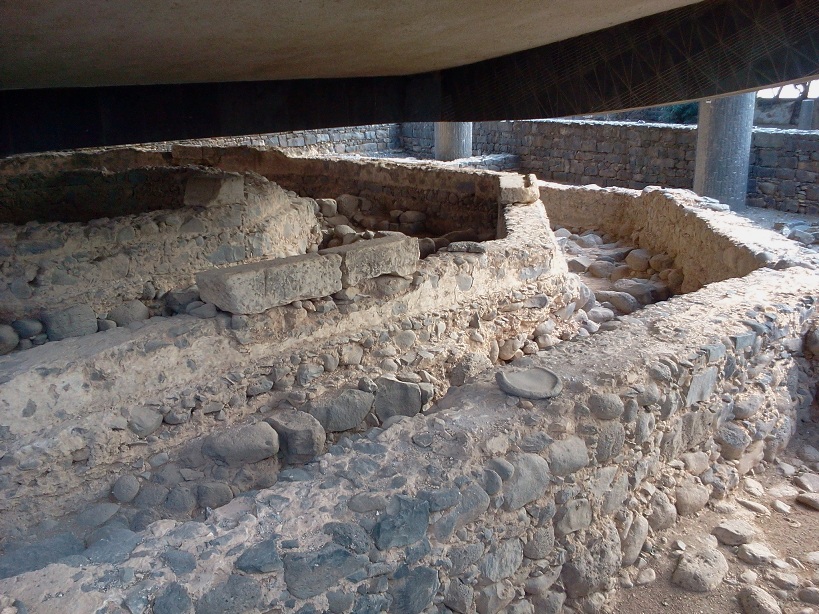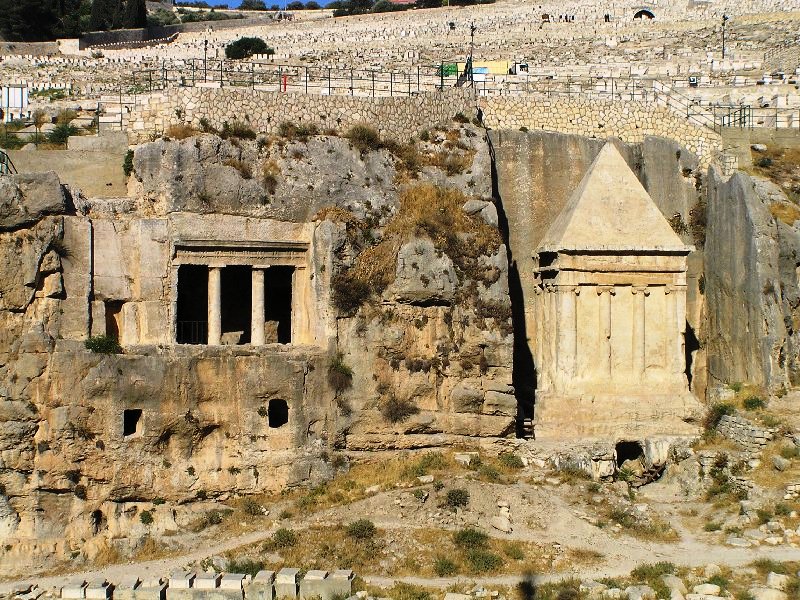
Where the Temple Was Not
I personally have difficulty with the concept of the continuity of Jewish tradition. Tradition tells us that down through the centuries, even millennia, the location of sites, and even cities, in Israel are correct because of tradition. They knew where things were.
An example of my difficulty is the City of David. Until the 19th Century, the location of the City of David was unknown. In 1838 Edward Robinson discovered Hezekiah’s Tunnel beneath the area later confirmed to be the City of David. It was not known with certainty that this was Hezekiah’s Tunnel until the discovery of the inscription in the tunnel in 1884 noting that it was dug through the bedrock at the command of King Hezekiah. The tunnel was dug to give access to the water of the Gihon Spring while they were under siege, and confirms the location of the City of David.
The point is – the City of David had been lost!
In Bible times, graves were always outside the city. In the Kidron Valley, opposite the City of David, is a necropolis, a city of graves. An exception was made for King David and his royal house, who were buried in the City of David. (I Kings 2:10, I Kings 11:43, I Kings 14:31)
In 1913, a French-Jewish scholar named Raymond Weill was commissioned to excavate in the City of David, and specifically to search for the site of the royal tombs. He found what could be described as a large tomb. The tomb was empty and had probably been pillaged by the Romans in 70 A.D. It had been destroyed when the City of David was used as a stone quarry by the Romans after the destruction of Jerusalem. This was not an ordinary tomb because the walls had been plastered to give it a finished appearance. It is very possible that this was the location of the Tomb of King David in the City of David as described in the Bible. (Nehemiah 3:16)
The Tomb of David had been lost – and it still is. Today, there is a purported Tomb of David in a building dating back to about 1000 A.D. on the Western Hill of Jerusalem outside of the City of David. Recall, King David lived about 3000 years ago.
Actually, the people of Israel have lost an entire mountain. The Western Hill is called Mount Zion. This is not Mount Zion. Mount Zion has been lost.
The Bible tells us the location of Mount Zion and the location of the Temple, both of which are in the City of David. First, the Lord said that He would chose a place for His name to be worshipped. (Deuteronomy 12:5, 12:11, 16:2, 16:6) Next, the Lord told us where He would place His name, which was Mount Zion. (Psalm 9:11, 48:2, 74:2, 76:2, 132:13, Isaiah 18:7) Finally, the Bible tells us where Mount Zion is located, and that is the City of David. (II Samuel 5:7, I Kings 8:1, I Chronicles 11:5, II Chronicles 5:2) Mount Zion is not the Western Hill.
So memory, and tradition, have failed. Based on Holy Scripture, the Temple of God was located in the City of David, on Mount Zion!
That means that the walled fort on the traditional Temple Mount was never the location of the Temple – for the Bible tells me so.
The Foundation of the Dome of the Rock
The early church had no buildings. Believers worshipped from house to house. (Acts 2:46) Because of persecution, the early church met in secret places. According to church historians, the construction of buildings for worship was rare until the Edict of Milan in 315 A.D. in which the Roman Empire allowed religious toleration for Christians.
The Byzantines, or the Eastern Roman Empire, were the builders of most of the early church buildings. These buildings had at least two common characteristics; they were built over any “religious” site of note, and they had octagonal foundations.
The Holy Land has many churches built over Biblical locations. Here is a picture of the traditional site of the Apostle Peter’s home in Capernaum. You will note that the foundation is octagonal. There is a more modern church building over this ancient site.

I point this out because early Church historians note that the Byzantines built a church over the place that they believed to be the Praetorium of Pilate, where the Lord Jesus was condemned to die. The Byzantines believed that the massive edifice standing in Jerusalem was the Roman Fort Antonia, and constructed their church there. It was called the Church of Holy Wisdom and was built circa 335 A.D.
This was long before the Roman fort became traditionally known as the Temple Mount.
The church had an octagonal foundation, like so many other Byzantine churches, and was destroyed when the Muslims conquered Jerusalem in 637 A.D. Later the Mosque of Omar, or the Dome of the Rock, with its octagonal foundation was built on the original foundations of the Church of Holy Wisdom.
My conclusion of these facts is that the Roman Byzantines believed that the Praetorium was located on the Roman Fort Antonia, and built a church over the Praetorium as was their custom of building over Biblical sites. This building, with its typical octagonal foundation, was destroyed by the Muslims and then they placed their mosque on the same location. If my conclusions are correct, the Muslim Dome of the Rock is honoring and protecting the very place believed to be where the Devil thought he had won the victory over the Lord Jesus.
As noted above, Scripture tells us that the Temple of God was located in the City of David.
The traditional Temple Mount, the traditional Tomb of King David, the traditional location of Mount Zion are all wrong. These facts show us that tradition can be deceptive and misleading.
But the Word of God is our Rock. Praise the Lord for His Bible!
The Site of the Crucifixion
Our Brother, Bob Cornuke, has written a book called Golgotha. In this book he pointed out Scripture that indicates the site of the crucifixion and burial of Jesus are east of the Temple.
The Temple faced toward the East. This is based on Scripture. The Tabernacle in the wilderness faced East. (Numbers 3:38) The Millennial Temple will face toward the East. (Ezekiel 47:1)
Sacrifices made to the Lord were burned on the altar, which was east of the Temple. The Temple faced east and the altar was before the door of the Temple. (Leviticus 4:7, 16:18, Exodus 29:10) When Aaron and his sons were consecrated, they were presented before the “door” of the Tabernacle. (Exodus 29:4) All important actions took place in front of, or east of, the Temple.
The Lord Jesus was the sacrifice of all sacrifices. (Hebrews 7:27, 10:10) Jesus was the Lamb of God. (John 1:29) The Passover lamb was chosen on the tenth day of Nisan. (Exodus 12:3) The day known as “Palm Sunday” when Jesus was “chosen” by the people probably was Nisan 10.
In Egypt the blood of the sacrificed Passover lamb was placed on the lintel (overhead) and jambs (sides) of the door. These marks of blood then were in the form of a cross. Later, Jesus was sacrificed at the same time as the Passover lambs. This was at the time of the “evening oblations,” or the ninth hour of the day (3:00 in the afternoon). (Mark 15:34-37) All of these events fit the pattern of the sacrifice of the Passover lamb. In order for the crucifixion, or sacrifice, of Jesus to continue to fit the pattern, He had to be sacrificed east of the Temple.
The problem with the location of the traditional sites regarding the death of Jesus, such as the Church of the Holy Sepulcher and Gordon’s Calvary, is that they both are west of the City of David, the location of the Temple of God. The crucifixion had to occur east of the Temple. The Mount of Olives is east of the City of David and extends north along the Kidron Valley.
A large part of the Mount of Olives is a huge cemetery. The crucifixion was near the city (John 19:20) as is the Mount of Olives. Joseph of Arimathea had a new tomb close to the crucifixion site (John 19:41) and probably on the Mount of Olives.

Because the Bible says that the Temple was built in the City of David, or Zion, then the site of the crucifixion would have been east of the Temple on the southern part of the Mount of Olives. There are numerous tombs on this mount and in the face of the cliff beneath it, facing the City of David.
Holy Scripture and facts once again have defeated tradition. Tradition can lead you astray. Praise the Lord for His Holy Scripture! May His name always be praised!